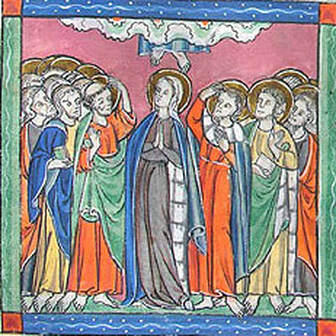|
This small illumination is from a manuscript made in England in the late 13th and early 14th century and is found in the Old Library, St John’s College, Cambridge. At first glance it’s quite easy to miss the narrative. A woman stands in the centre surrounded by a group of men wearing brightly coloured robes. Her hands are held together in prayer, while others gesture in surprise and amazement. What are they all doing? The answer is at the top of the image where we can just see two feet and the bottom of a blue robe disappearing into a cloud.
It is, of course, the Biblical story of the Ascension and the two feet belong to the risen Christ.The original narrative is told at the beginning of the Book of Acts and the illuminator seems to have followed the biblical text closely: “After he said this, he was taken up before their very eyes, and a cloud hid him from their sight” (Acts 1:9). By showing only his feet, the artist captures the exact moment when Christ vanishes from the earthly realm into the presence of God. This particular iconography is found in other medieval depictions of the scene and is rather aptly referred to as the ‘Disappearing Christ’. Like many medieval manuscripts, the colours of this illumination are vibrant and well preserved. The figures stand gracefully in their flowing garments, their feet almost floating above the ground, echoing the feet of the ascending Christ. The cloud, into which he disappears, is an abstract pattern of white, orange and green. Colours held meaning in the medieval world and the green may be used here as a symbol of resurrection and new life, rather than as a reflection of a physical reality. Ascension Day, celebrated yesterday in the Western Church, has its own particular tradition at St John’s. Every year, the college choir climb up to the roof of the 163ft chapel tower and sing an Ascension carol. It all started in 1902 after a discussion between the college’s director of music, Cyril Rootham and one of the fellows, Sir Joseph Larmor. Sir Joseph insisted that a choir singing from the top of the tower would not be heard by those standing on the ground below and Cyril was keen to prove him wrong. Without telling anyone, on Ascension Day, the choir climbed the tower and as the clock struck noon, they sang an Ascension Day motet. To Cyril’s great delight, Sir Joseph opened his window in the courtyard below to hear where the music was coming from! Sadly, the choir were not able to sing from the tower this year, but we are still able to enjoy the treasures of the college’s extensive manuscript collection and look forward to hearing the choir sing on Ascension Day in 2021 - a date for the diary. Above: Canticles, Hymns and Passion of Christ, manuscript MS K. 21 folio 61v, parchment, full page size 32 x 23 cm, illustrated image approximately 10 x 8 cm, Old Library, St John's College, Cambridge.
1 Comment
|
AuthorAll posts written and researched by Sarah Burles, founder of Cambridge Art Tours. The 'Art Lover's Guide to Cambridge' was sent out weekly during the first Covid 19 lockdown while Cambridge museums, libraries and colleges were closed. Archives
December 2020
Categories |

 RSS Feed
RSS Feed